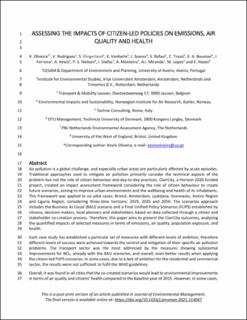| dc.description.abstract | Air pollution is a global challenge, and especially urban areas are particularly affected by acute episodes. Traditional approaches used to mitigate air pollution primarily consider the technical aspects of the problem but not the role of citizen behaviour and day-to-day practices. ClairCity, a Horizon 2020 funded project, created an impact assessment framework considering the role of citizen behaviour to create future scenarios, aiming to improve urban environments and the wellbeing and health of its inhabitants. This framework was applied to six pilot cases: Bristol, Amsterdam, Ljubljana, Sosnowiec, Aveiro Region and Liguria Region, considering three-time horizons: 2025, 2035 and 2050. The scenarios approach includes the Business As Usual (BAU) scenario and a Final Unified Policy Scenarios (FUPS) established by citizens, decision-makers, local planners and stakeholders based on data collected through a citizen and stakeholder co-creation process. Therefore, this paper aims to present the ClairCity outcomes, analysing the quantified impacts of selected measures in terms of emissions, air quality, population exposure, and health.
Each case study has established a particular set of measures with different levels of ambition, therefore different levels of success were achieved towards the control and mitigation of their specific air pollution problems. The transport sector was the most addressed by the measures showing substantial improvements for NO2, already with the BAU scenarios, and overall, even better results when applying the citizen-led FUPS scenarios. In some cases, due to a lack of ambition for the residential and commercial sector, the results were not sufficient to fulfil the WHO guidelines.
Overall, it was found in all cities that the co-created scenarios would lead to environmental improvements in terms of air quality and citizens’ health compared to the baseline year of 2015. However, in some cases, the health impacts were lower than air quality due to the implementation of the measures not affecting the most densely populated areas. Benefits from the FUPS comparing to the BAU scenario were found to be highest in Amsterdam and Bristol, with further NO2 and PM10 emission reductions around 10%–16% by 2025 and 19%–28% by 2050, compared to BAU. | en_US |

